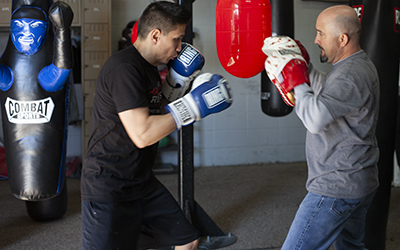
When a fighter first starts training, it can be hard to contain their fire and passion. It’s all you can do to keep up with them as they eat up everything you throw down.
But then, sometimes, you can’t seem to connect. You can’t get them to see the value of a particular exercise. Or you can’t get them to understand why they need to “fix” they way they throw their cross.
In those situations, you need to find a way to break through and get on the same page. Read on to learn about some of the tactics that might help motivate your fighters.
What Not To Do
When faced with a situation where an athlete just can’t click with the training plan, we’re often presented with one of two options: the carrot or the stick.

Incentives (the carrot) work out well in the short run, but they don’t work forever. They also require constant escalation to keep having an impact.
Fear, punishment, and browbeating (the stick) can also be effective, but they can easily backfire. And not everyone will respond.
True motivation, though, isn’t about a stick or a carrot. It’s about building something personal and unique with your fighter. Something that starts (or reignites) a fire inside of them that you help direct.
1. Set Goals; Create Purpose
For a lot of people, it can be hard to maintain motivation if they can’t see the finish line. This is where setting goals comes in. When your athletes understand what they’re working for, it can change everything.
Work with your fighter to create both short term goals (nailing down that new combination) and long term goals (competing for a spot on the Olympic team). This creates a shared sense of purpose for you both.
Without a clear goal, all the work and sacrifice this sport demands can feel like needless struggle. With a goal, with a purpose, all that hard work becomes a stepping stone to success.
2. Be Transparent

It would be nice if “because I said so” was enough for everyone. But even my four year old will only tolerate that reason so many times before it loses its effectiveness.
Though it may be difficult and tiresome, in many cases you will be better off explaining the reasons for your training choices. If a fighter understands that shadowboxing is where you train speed and muscle-memory, maybe they won’t push back on the hours spent punching air. If a fighter understands that good footwork is almost more important than punching power, then they might not object to those footwork drills.
At the end of the day, an athlete that understand the why behind each aspect of training will be more likely to commit and to own the process.
3. Recognize Success

Most of the time, motivation is about being seen. By our coach. By our family. By our peers. When we know people are watching and like what we’re doing, we are more likely to maintain motivation.
Knowing this, it’s important to recognize our fighters’ successes. Simply saying, “well done,” at the right time can have a huge impact on a trainee’s confidence and willingness to keep pushing.
But beyond just commending an athlete in the moment, you also need to take time to communicate a fighter’s success to their families and in front of their peers.
Even the people who aren’t the best fighters in the gym have some aspect of their game that warrants validation.
4. Learn from Failure
Failure is inevitable. People will make mistakes. Treat mistakes and failures as opportunities to learn.
If a fighter knows that errors or failure will lead to ridicule or disappointment, then they may stop attempting to leap forward. Instead they will stick with what they know, and that will feel limiting.
If, on the other hand, they know that failure will be met constructively, there is every chance that they will rush to try new things or push outside their comfort zone. Because you’ll be there to catch them.
5. Make them a Part of the Process

Lack of control may be the number one reason that human beings become frustrated with a process or a situation. When someone feels that they have no ability to impact what happens, then they may become frustrated and quit.
If you took the time to engage with the first item on this list, then you’ve already taken a step toward an inclusive process. But this goes beyond just setting goals. Making your athlete part of the process means asking them for input into what the training regimen looks like.
This element can feel scary, because it involves giving up a measure of control. But having a fighter who feels engaged in the program, and a real ownership in the process can mean having a fighter who shows up every day with a passion.
Not all of these will work for every fighter or coach. But if you give them a shot, you may see some amazing results.


Good Article
Its a thinking sport!
Peewee Boxers and coach(s) need to understand each other and trust..
Spending Endless hours together is not the answer at that age. It’s the quality of time spent in training will result in a quality win. Understanding is key to all success.
Everything else will follow.
Because when the bell rings you only have a split second to think. Every fighter needs a good corner man. Boxers rise on there wins. Most take there loses as a disaster. Some add it to there lists of bouts. And a few mark it up as a learning experience.
My point for boxes. They need to focus on the quality of there training and ring time. Showing up sparring a couple rounds is not the answer..
Every second counts.. W/L
End of story!